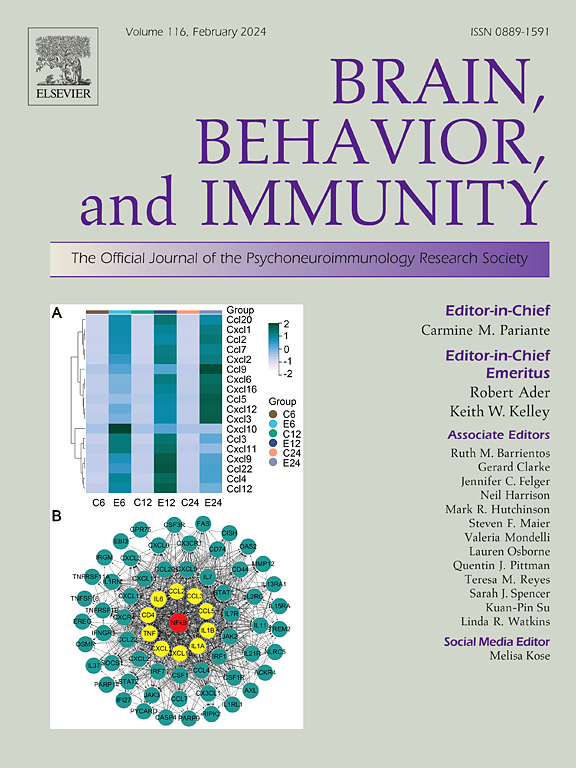Effects of kynurenine pathway metabolites on choroid plexus volume, hemodynamic response, and spontaneous neural activity: A new mechanism for disrupted neurovascular communication and impaired cognition in mood disorders
IF 8.8
2区 医学
Q1 IMMUNOLOGY
引用次数: 0
Abstract
Major Depressive Disorder (MDD) and Bipolar Disorder (BD) involve alterations of immune-inflammatory setpoints that activate the kynurenine pathway (KP), affecting serotoninergic and glutamatergic neurotransmission through indoleamine-2,3-dioxygenase (IDO) activity. This process produces metabolites like Kynurenine (Kyn), 3-Hydroxykynurenine (3-HK), Quinolinic acid (QuinA), and Kynurenic acid (KynA), these last two acting as agonist and antagonist at glutamatergic N-methyl-D-aspartate receptors (NMDARs), respectively. NMDARs, expressed in the choroid plexus (ChP) and arteriolar smooth muscle cells, regulate blood–brain-barrier permeability and cerebral artery dilation, suggesting that KP may influence neurovascular coupling, aligning blood flow with neural energy demand. KP’s role in modulating vascular tone supports this hypothesis. Altered fractional amplitude of low-frequency fluctuations (fALFF) and disrupted default mode network (DMN) activity in mood disorders are linked to cognitive deficits possibly through neurovascular uncoupling like in neurological diseases. This makes fALFF and hemodynamic response function (HRF) potential indicators of these changes. We investigated KP associations with ChP volumes, functional-MRI at rest measures like spontaneous neural activity (fALFF) and hemodynamic response function (HRF) parameters within the default mode network (DMN), and cognitive performance in 42 MDD and 36 BD inpatients experiencing a depressive episode.
Results revealed that lower QuinA/KynA ratios and higher KynA levels predict larger ChP volumes. Higher KYN and 3-HK levels, along with lower KynA levels, were associated with increased DMN fALFF and shorter time-to-peak (TTP) in HRF, suggesting altered neurovascular coupling. Mediation analyses indicated that KP metabolites influenced cognitive performance through their effects on resting state measures, affecting global cognitive functioning score, verbal fluency, and psychomotor coordination. These findings suggest that KP metabolites modulate brain function and structure via NMDAR-mediated pathways and vascular-based mechanisms, offering insights into the cognitive impairments observed in mood disorders and identifying potential therapeutic targets.
求助全文
约1分钟内获得全文
求助全文
来源期刊
CiteScore
29.60
自引率
2.00%
发文量
290
审稿时长
28 days
期刊介绍:
Established in 1987, Brain, Behavior, and Immunity proudly serves as the official journal of the Psychoneuroimmunology Research Society (PNIRS). This pioneering journal is dedicated to publishing peer-reviewed basic, experimental, and clinical studies that explore the intricate interactions among behavioral, neural, endocrine, and immune systems in both humans and animals.
As an international and interdisciplinary platform, Brain, Behavior, and Immunity focuses on original research spanning neuroscience, immunology, integrative physiology, behavioral biology, psychiatry, psychology, and clinical medicine. The journal is inclusive of research conducted at various levels, including molecular, cellular, social, and whole organism perspectives. With a commitment to efficiency, the journal facilitates online submission and review, ensuring timely publication of experimental results. Manuscripts typically undergo peer review and are returned to authors within 30 days of submission. It's worth noting that Brain, Behavior, and Immunity, published eight times a year, does not impose submission fees or page charges, fostering an open and accessible platform for scientific discourse.

 求助内容:
求助内容: 应助结果提醒方式:
应助结果提醒方式:


